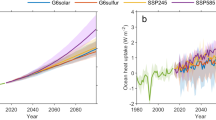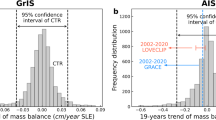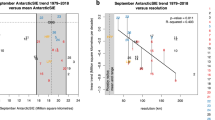Abstract
Enhancement of the Earth’s albedo through the injection of sulfate aerosols into the stratosphere has been proposed as an approach to offset some of the adverse effects of climate change. Here we analyse an ensemble of simulations of the twenty-first century climate designed to explore a strategic geoengineering approach. Specifically, stratospheric sulfur injections are imposed at 15° and 30° in both hemispheres with the aim to minimize the changes in surface temperature, both in the global mean and in its gradients between hemispheres and from equator to pole. The approach accomplishes these goals and reduces previously noted adverse impacts of solar radiation management, such as excessive cooling in the tropics and weakening rainfall over land. Nonetheless, hydrological responses over the North Atlantic Ocean lead to an acceleration of the Atlantic meridional overturning circulation and to continued warming of the deep and polar oceans, particularly in the vicinity of southern Greenland. These changes could cause continued, albeit slower, cryospheric melt and global sea level rise. Our simulations demonstrate the complexity of the coupled climate response to geoengineering and highlight the need for significant advances in our ability to simulate the coupled climate system and the continued refinement of geoengineering strategies as a prerequisite to their successful implementation.
This is a preview of subscription content, access via your institution
Access options
Access Nature and 54 other Nature Portfolio journals
Get Nature+, our best-value online-access subscription
$29.99 / 30 days
cancel any time
Subscribe to this journal
Receive 12 print issues and online access
$259.00 per year
only $21.58 per issue
Buy this article
- Purchase on Springer Link
- Instant access to full article PDF
Prices may be subject to local taxes which are calculated during checkout




Similar content being viewed by others
Data availability
The data sets analysed during this study are available on the Earth System Grid (https://www.earthsystemgrid.org and http://www.cesm.ucar.edu/projects/community-projects/GLENS/).
References
Crutzen, P. J. Albedo enhancement by stratospheric sulfur injections: a contribution to resolve a policy dilemma? Clim. Change 77, 211–219 (2006).
Kleypas, J. et al. Geochemical consequences of increased atmospheric carbon dioxide on coral reefs. Science 284, 118 (1999).
Cao, L. The effects of solar radiation management on the carbon cycle. Curr. Clim. Change Rep. 4, 41–50 (2018).
Haywood, J. M. A., Jones, N., Bellouin & Stephenson, D. Asymmetric forcing from stratospheric aerosols impacts Sahelian rainfall. Nat. Clim. Change 3, 660–665 (2013).
Tilmes, S. et al. The hydrological impact of geoengineering in the Geoengineering Model Intercomparison Project (GeoMIP). Geophys. Res. Lett. 118, 11–036 (2013).
Jones, A. C. et al. Impacts of hemispheric solar geoengineering on tropical cyclone frequency. Nat. Commun. 8, 1382 (2017).
Kravitz, B. et al. First simulations of designing stratospheric sulfate aerosol geoengineering to meet multiple simultaneous climate objectives. J. Geophys. Res. Atmos. 122, 12616–12634 (2017).
Tilmes, S. et al. CESM1(WACCM) Stratospheric Aerosol Geoengineering Large Ensemble (GLENS) project. Bull. Am. Meteorol. Soc. https://doi.org/10.1175/BAMS-D-17-0267.1 (2018).
Mills, M. J. et al. Radiative and chemical response to interactive stratospheric sulfate aerosols in fully coupled CESM1(WACCM). J. Geophys. Res. Atmos. 122, 13061–13078 (2017).
Richter, J. H. et al. Stratospheric dynamical response and ozone feedbacks in the presence of SO2 injections. J. Geophys. Res. Atmos. 122, 12557–12573 (2017).
Kushnir, Y. Interdecadal variations in the North Atlantic sea surface temperature and associated atmospheric conditions. J. Clim. 7, 141–157 (1994).
Delworth, T. L. & Mann, M. E. Observed and simulated multidecadal variability in the Northern Hemisphere. Clim. Dyn. 16, 661–676 (2000).
Zhang, R. On the persistence and coherence of subpolar sea surface temperature and salinity anomalies associated with the Atlantic multidecadal variability. Geophys. Res. Lett. 44, 7865–7875 (2017).
Phillips, A., Deser, C. & Fasullo, J. Evaluating modes of variability in climate models. Eos Trans. AGU 95, 453–455 (2015).
Moore, J. C., Jevrejeva, S. & Grinsted, A. Efficacy of geoengineering to limit 21st century sea-level rise. Proc. Natl Acad. Sci. USA 107, 15699–15703 (2010).
Irvine, P. J. et al. The fate of the Greenland Ice Sheet in a geoengineered, high CO2 world. Environ. Res. Lett. 4, 045109 (2009).
Irvine, P. J., Keith, D. W. & Moore, J. Brief communication: understanding solar geoengineering’s potential to limit sea level rise requires attention from cryosphere experts. Cryosphere 12, 2501–2513 (2018).
Overpeck, J. T. et al. Paleoclimatic evidence for future ice-sheet instability and rapid sea-level rise. Science 311, 1747–1750 (2006).
Favier, L. et al. Retreat of Pine Island Glacier controlled by marine ice-sheet instability. Nat. Clim. Change 4, 117–121 (2014).
Pollard, D., DeConto, R. & Alley, R. Potential Antarctic ice sheet retreat driven by hydrofracturing and ice cliff failure. Earth Planet. Sci. Lett. 412, 112–121 (2015).
Chylek, P., Dubey, M. K. & Lesins, G. Greenland warming of 1920–1930 and 1995–2005. Geophys. Res. Lett. 33, L11707 (2006).
Zhang, R. & Delworth, T. L. Impact of Atlantic multidecadal oscillations on India/Sahel rainfall and Atlantic hurricanes. Geo. Res. Lett. 33, L17712 (2006).
Krishnamurthy, L. & Krishnamurthy, V. Teleconnections of Indian monsoon rainfall with AMO and Atlantic tripole. Clim. Dyn. 46, 2269–2285 (2016).
Frankignoul, C., Gastineau, G. & Kwon, Y. Estimation of the SST response to anthropogenic and external forcing and its impact on the Atlantic multidecadal oscillation and the Pacific decadal oscillation. J. Clim. 30, 9871–9895 (2017).
Ineson, S. et al. Solar forcing of winter climate variability in the Northern Hemisphere. Nat. Geosci. 4, 753–757 (2011).
Muthers, S., Raible, C. C., Rozanov, E. & Stocker, T. F. Response of the AMOC to reduced solar radiation—the modulating role of atmospheric chemistry. Earth Syst. Dynam. 7, 877–892 (2016).
Otterå, O. H., Bentsen, M., Drange, H. & Suo, L. External forcing as a metronome for Atlantic multidecadal variability. Nat. Geosci. 3, 688–694 (2010).
Scaife, A. A. et al. A mechanism for lagged North Atlantic climate response to solar variability. Geophys. Res. Lett. 40, 434–439 (2013).
Swingedouw, D. et al. Natural forcing of climate during the last millennium: fingerprint of solar variability. Clim. Dynam. 36, 1349–1364 (2011).
Mills, M. J. et al. Global volcanic aerosol properties derived from emissions, 1990–2014, using CESM1(WACCM). J. Geophys. Res. Atmos. 121, 2332–2348 (2016).
Liu, X. et al. Toward a minimal representation of aerosols in climate models: description and evaluation in the Community Atmosphere Model CAM5. Geosci. Model Develop. 5, 709–739 (2012).
Kay, J. E. et al. The community earth system model (CESM) large ensemble project: a community resource for studying climate change in the presence of internal climate variability. Bull. Am. Meteorol. Soc. 96, 1333–1349 (2015).
Trenberth, K. E. & Shea, D. J. Atlantic hurricanes and natural variability in 2005. Geophys. Res. Lett. 33, 12 (2006).
Acknowledgements
The authors acknowledge support from NASA award no. 80NSSC17K0565 and NSF award no. 1243107. The Pacific Northwest National Laboratory is operated for the US Department of Energy by Battelle Memorial Institute under contract DE-AC05-76RL01830. This research was developed with funding from the Defense Advanced Research Projects Agency. The views, opinions and/or findings expressed are those of the authors and should not be interpreted as representing the official views or policies of the Department of Defense or the US Government.
Author information
Authors and Affiliations
Contributions
J.T.F. performed the core analysis, interpretation of results and writing. S.T. and J.H.R. performed the experiments and contributed to manuscript revisions. B.K. envisioned and designed the experimental set-up. D.G.M. contributed to the experimental set-up and manuscript revisions. M.J.M. and I.R.S. contributed to group discussions and manuscript revisions.
Corresponding author
Ethics declarations
Competing interests
The authors declare no competing interests.
Additional information
Publisher’s note: Springer Nature remains neutral with regard to jurisdictional claims in published maps and institutional affiliations.
Rights and permissions
About this article
Cite this article
Fasullo, J.T., Tilmes, S., Richter, J.H. et al. Persistent polar ocean warming in a strategically geoengineered climate. Nature Geosci 11, 910–914 (2018). https://doi.org/10.1038/s41561-018-0249-7
Received:
Accepted:
Published:
Issue Date:
DOI: https://doi.org/10.1038/s41561-018-0249-7
This article is cited by
-
Climate intervention on a high-emissions pathway could delay but not prevent West Antarctic Ice Sheet demise
Nature Climate Change (2023)
-
Atmospheric rivers impacting western North America in a world with climate intervention
npj Climate and Atmospheric Science (2022)
-
Uncertainty and the basis for confidence in solar geoengineering research
Nature Reviews Earth & Environment (2020)
-
Mitigation of Arctic permafrost carbon loss through stratospheric aerosol geoengineering
Nature Communications (2020)



